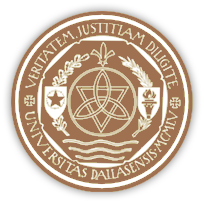Table of Contents: Volume 1, Issue 1
Volume One
Editor-in-Chief: Jonathan McDonald (Master's student, Humanities)
Managing Editor: D. William Turnage (PhD candidate, Literature)
Editors:
Adam Cooper (PhD student, Literature)
Peter S. Hermanson (PhD student, Philosophy)
Amos Hunt (PhD student, Philosophy)
Faculty Advisor
Eileen Gregory
Faculty Review Board
Bainard Cowan (Literature), Jonathan Culp (Politics),
Christopher Malloy (Theology), Andrew Osborn (Literature),
Joshua Parens (Philosophy), Robert Wood (Philosophy)
Ramify appreciates our financial supporters:
Braniff Graduate Student Association, Charles Claunch, President
Braniff Graduate School of Liberal Arts, Dr. David Sweet, Dean
Cover and book design: Sara Rosenberg
Logo design: Charity Hunt
Seed Leaves
by Richard Wilbur
Analogy, Dialectic, and Divine Transcendence: Between St. Thomas and Hegel
by William Desmond
No Nudes: Plato’s Sketches of the Soul
by John Tutuska
Abstract:
Plato treats the reader to a variety of images (often mythological) of the human soul. Whatever Plato thinks about the forms in general, the centrality of this imagery for his anthropology may suggest that he regards a direct viewing of the human form (or soul) as impossible. This paper attempts to reveal the underlying structures and possibilities of this Platonic imagery, beginning by considering a passage from the Phaedrus in which Socrates seems to resist demythologization so that he can preserve mythic tales as material for his psychology. Instead of a flatly introspective method of self-knowledge, Plato’s Socrates seems to recommend moving outward, seeking to find the soul in the stories that we tell. As human creations, these stories refract human nature back to us. These images can further be compared to caricatures insofar as caricatures serve to reveal features that had been masked by familiarity. Additionally, Plato’s move to stretch the soul between the poles of the bestial and divine serves to remind us that we cannot decisively determine it as either, and thus that there is no one look [eidos] of the soul. Plato’s imagistic treatment can be situated within a larger Greek tradition, as becomes evident in looking to Homer as predecessor and Aristotle as successor.
The Rhetoric of Storytelling in The Golden Ass
by Spencer Kyle Smith
Abstract:
Often overlooked in discussions of the great books, The Golden Ass (a multifaceted, lively work of Latin prose from the 2nd century) addresses the most basic questions implicit within the western literary tradition: “what are stories, and what good are they for us?” The Golden Ass is the story of a curious journeyman named Lucius who is magically transformed into an ass and then led on a kind of odyssey throughout the Greco-Roman world. His time as an ass forces him to hear the stories of others; hence, The Golden Ass is largely made up of other stories. Smith argues that this tale-within-a-tale structure is the narrative’s most important element, as it allows Apuleius to call attention to the importance of interpretation and the problem of delineating meaning in stories. Through various encounters with tales, the protagonist Lucius is led on a spiritual journey from moral thoughtlessness to spiritual awareness. Hence, far more than a collection of bawdy stories or mere religious propaganda, The Golden Ass proves a veritable a commentary on the spiritual aspect of fiction, and the final outcome of Lucius’s experiences with stories demonstrate the utility of a proper understanding of tales as highly practical vehicles of meaning.
That Mortal God: Christianity, Sovereignty, and Civil Religion in Hobbes’s Leviathan
by Jennifer Bralick
Abstract:
In the Leviathan, Hobbes develops a subtle argument regarding Christianity and civil sovereignty that, if followed closely, has enormous implications for his argument as a whole. On the surface, I argue, he simply presents Christianity in a somewhat worldly light, suggesting that one of its primary effects is inclining man to civil society and what we might call social civility. However, the underlying thrust of the argument, developed in subtle and sporadic passages, in effect strips Christianity of its independent truth and places it under the power of the sovereign. The sovereign in Hobbes’s account has significantly greater political power than typically granted by Hobbes’s contemporaries. But more than this, Hobbes’s treatment of Christianity implicitly accords the sovereign not only papal-like power, but even god-like power. This paper will offer a careful analysis of Hobbes’s varying and sometimes contradictory accounts of religion and civil sovereignty, to attempt to better understand his overall argument regarding Christianity and political power.
Friedrich Nietzsche and the Phenomenology of Prayer
by Robert E. Wood
Abstract:
At nineteen Nietzsche penned a prayer “To an Unknown God” to whom he offered his service. Though he gave up on God, he did not give up on prayer, as his concluding prayer to the section, “The Yes and Amen Song,” indicates. His prayer had no self-serving purpose, only sheer praise and absolute dedication to Life. The analysis involves a step back to consider the bipolar structure of human existence that allows us to situate prayer as a phenomenon on the heart. Along with Nietzsche’s works, Plato, Augustine, Aquinas, Buber Hegel, Heidegger are enlisted in the exploration of prayer. We consider the notion of pietas, as a sense of unpayable indebtedness, and how this has been used to subordinate individuals to a paternalistic tradition and how Nietzsche’s thought can be used to purify that tradition. We also explore forms of prayer and a religious ecumenism that can legitimately join hands even with sincere atheists like Nietzsche. We underscore Nietzsche’s emphasis upon solitude as a way to purify tradition, beyond the Last Man, beyond the inverse cripples, beyond contempt for the earth, toward dwelling “in wholeness and fullness of being” in relation to the final Encompassing.
Beowulf (selections)
by Daniel Janeiro (translator)
Philosophy and Its History: An Analysis of Gilson’s Historical Method and Treatment of Neoplatonism
by Brian Garcia
Abstract:
This paper examines Etienne Gilson’s presentation and criticism of Christian Neoplatonism in Being and Some Philosophers in an effort to shed light upon the broader topic concerning the relationship between philosophy and its history. Part I provides a brief survey of different kinds of objections to Gilson pertaining to potential limitations of his historical method and metaphysical thesis. In order to avoid making sweeping claims regarding Gilson’s historical method on the whole, Part II then focuses on Gilson’s treatment of Christian Neoplatonism and offers a critique of his reading. Since Gilson’s philosophical insight rests upon a proper understanding of being, Neoplatonism is a most intriguing topic for examination because of the philosophical weight attributed to non-being. Lastly, Part III offers a brief reflection on both the nature of philosophic traditions and the consequences of accepting Gilson’s thesis and treatment of the history of philosophy. It is argued that Gilson’s brand of Thomism, with its conception of being as both metaphysical and revealed, does not allow for a meaningful dialogue with other competing traditions.
Braniff Page

